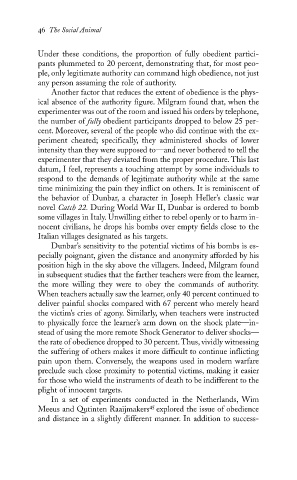Page 64 - The Social Animal
P. 64
46 The Social Animal
Under these conditions, the proportion of fully obedient partici-
pants plummeted to 20 percent, demonstrating that, for most peo-
ple, only legitimate authority can command high obedience, not just
any person assuming the role of authority.
Another factor that reduces the extent of obedience is the phys-
ical absence of the authority figure. Milgram found that, when the
experimenter was out of the room and issued his orders by telephone,
the number of fully obedient participants dropped to below 25 per-
cent. Moreover, several of the people who did continue with the ex-
periment cheated; specifically, they administered shocks of lower
intensity than they were supposed to—and never bothered to tell the
experimenter that they deviated from the proper procedure. This last
datum, I feel, represents a touching attempt by some individuals to
respond to the demands of legitimate authority while at the same
time minimizing the pain they inflict on others. It is reminiscent of
the behavior of Dunbar, a character in Joseph Heller’s classic war
novel Catch 22. During World War II, Dunbar is ordered to bomb
some villages in Italy. Unwilling either to rebel openly or to harm in-
nocent civilians, he drops his bombs over empty fields close to the
Italian villages designated as his targets.
Dunbar’s sensitivity to the potential victims of his bombs is es-
pecially poignant, given the distance and anonymity afforded by his
position high in the sky above the villagers. Indeed, Milgram found
in subsequent studies that the farther teachers were from the learner,
the more willing they were to obey the commands of authority.
When teachers actually saw the learner, only 40 percent continued to
deliver painful shocks compared with 67 percent who merely heard
the victim’s cries of agony. Similarly, when teachers were instructed
to physically force the learner’s arm down on the shock plate—in-
stead of using the more remote Shock Generator to deliver shocks—
the rate of obedience dropped to 30 percent.Thus, vividly witnessing
the suffering of others makes it more difficult to continue inflicting
pain upon them. Conversely, the weapons used in modern warfare
preclude such close proximity to potential victims, making it easier
for those who wield the instruments of death to be indifferent to the
plight of innocent targets.
In a set of experiments conducted in the Netherlands, Wim
Meeus and Qutinten Raaijmakers explored the issue of obedience
45
and distance in a slightly different manner. In addition to success-

